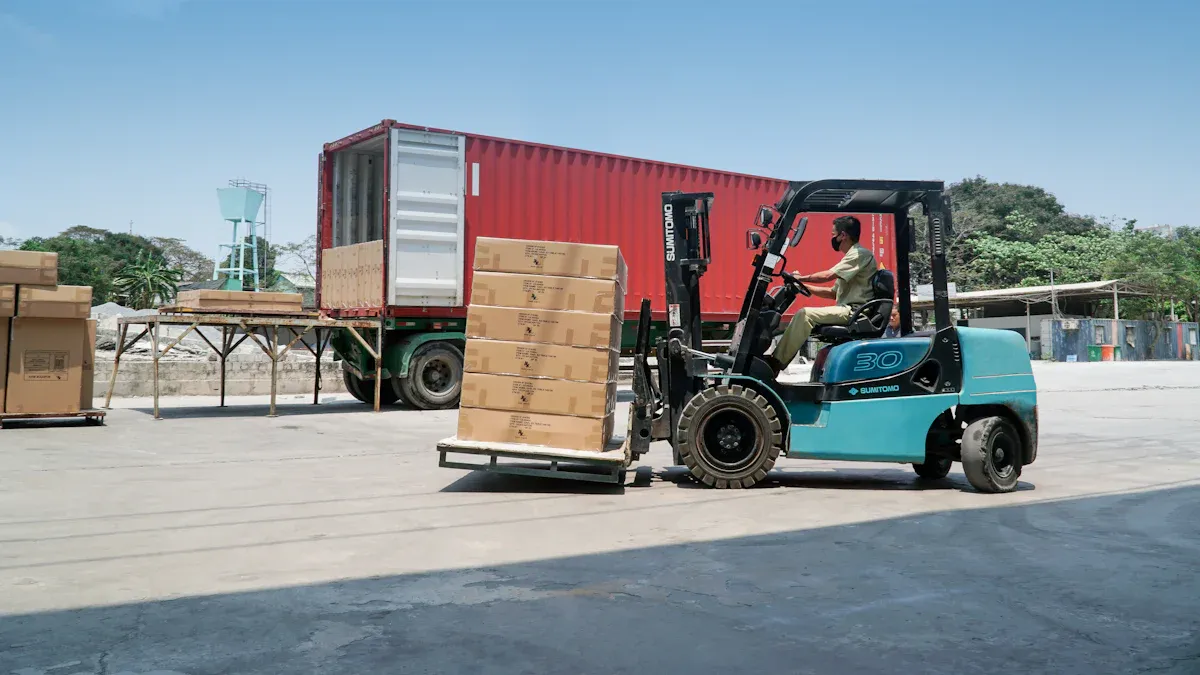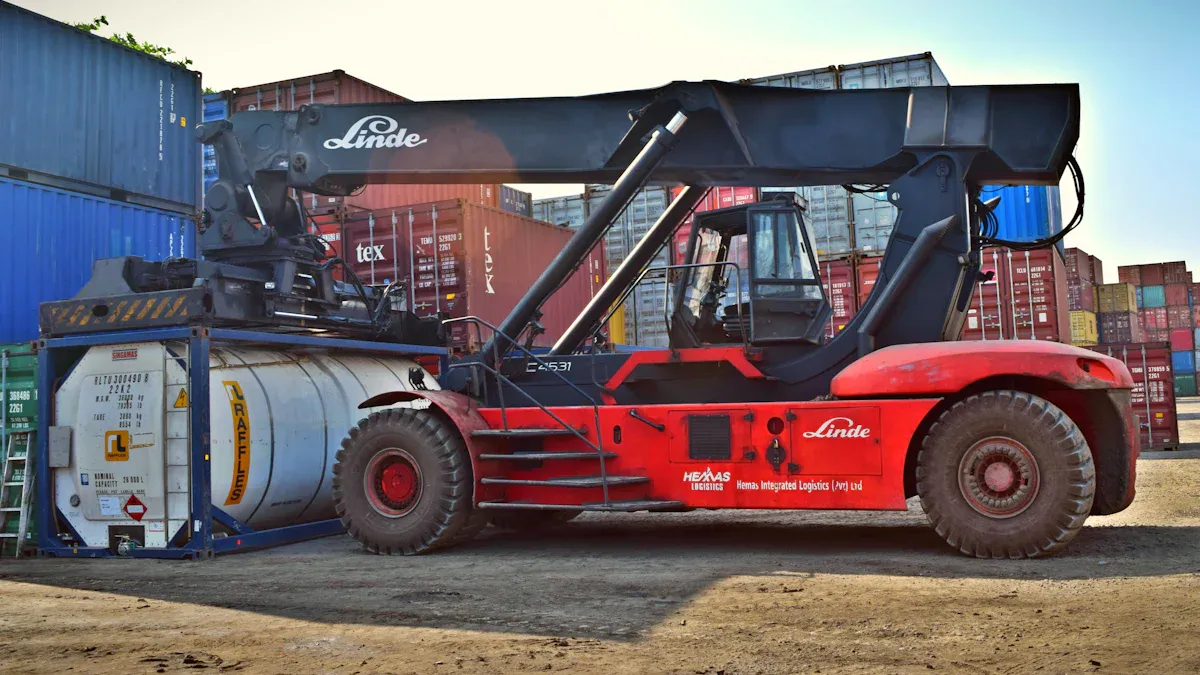

You operate a reach stacker by following clear steps that focus on safety and proper use of the controls. Always complete pre-use checks and daily maintenance before starting work. You need operator training to understand how to operate reach stacker safely and comply with regulations. Good training helps you prevent accidents and keep equipment in top condition.
Check controls before use
Perform safety inspections every day
Take part in operator training regularly
Tip: Stay alert and follow all safety rules when working with heavy machinery.
Reach stacker definition

What is a reach stacker
A reach stacker is a powerful vehicle you use to lift, move, and stack shipping containers in ports, terminals, and storage yards. You often see these machines working in busy logistics areas where containers need to be handled quickly and safely. The reach stacker definition includes its ability to move containers over short distances and stack them in rows, even reaching the second or third row with ease.
You rely on a reach stacker for several important tasks:
Stacking containers efficiently, including in second-row positions.
Moving containers weighing up to 45 metric tons within a terminal.
Offloading containers from trucks and trailers.
Repositioning containers to optimize space.
Operating in both tight and open spaces, adapting to different needs.
Improving productivity and reducing costs in container management.
Note: Reach stackers have transformed the logistics industry by making container handling faster and more flexible.
Main components
You need to understand the main parts of a reach stacker to operate it safely and effectively. Each component plays a key role in lifting and moving heavy loads.
Component | Function |
|---|---|
Engineering chassis | Holds the engine, gearbox, axles, steering system, cab, frame, counterweight, and wheels. |
Telescopic boom | Uses hydraulic cylinders to extend and lift containers to different heights and distances. |
Container spreader | Grips and secures containers with mechanisms like twist locks and side shift cylinders. |
These components work together to give you precise control over heavy containers. The chassis provides stability and support. The telescopic boom lets you reach containers stacked far back or high up. The spreader ensures you can safely lock onto containers of different sizes.
Safety checks

Pre-use inspection
You must inspect your reach stacker before every shift. This step helps you spot problems early and keeps you and others safe. Follow these top safety protocols to reduce risks and ensure safe lifting and stacking.
Check the boom and arm for cracks, bends, or weld repairs.
Test the twistlocks and spreader to make sure they engage and disengage properly.
Inspect the chassis and frame for corrosion, cracks, or signs of heavy impacts.
Look at hydraulic cylinders and hoses for leaks, scuffs, or dry spots.
Examine the engine for oil leaks, coolant leaks, and excessive smoke.
Inspect tires for uneven wear, sidewall damage, or missing chunks.
Test service brakes, parking brake, and emergency systems.
Try all controls, including joysticks and pedals, for quick response.
Review service records to confirm regular maintenance.
Make sure the load chart is visible and easy to read.
Safety tip: Always walk around the machine and check for obstacles or damage before starting. This habit can prevent accidents like rollovers or tip-overs, which account for nearly a quarter of all reach stacker incidents.
Daily maintenance
You need to perform daily maintenance to keep your reach stacker in good working order. Start with a visual inspection. Look for leaks, loose or damaged parts, and check tire condition. Make sure hydraulic fluid levels are correct. Test all safety devices, such as lights and alarms, to confirm they work.
Check oil, coolant, and tire pressure.
Inspect brakes, lights, horn, and fire extinguisher.
Walk around the machine to spot damage or obstacles.
Inspect the cab, lift arms, and ground for hazards.
Regulatory bodies set strict rules for safety checks. OSHA, IMO, and ILO all play a role in keeping logistics operations safe.
Regulatory Body | Role in Safety Checks |
|---|---|
OSHA | Sets safety standards for powered industrial trucks, including reach stackers. |
IMO | Provides guidelines for terminal operations and safety protocols. |
ILO | Establishes worker safety standards relevant to logistics operations. |
Reach stackers fall under OSHA regulations for powered industrial trucks. You must comply with 29 CFR 1917.43 and meet training requirements in 29 CFR 1910.178(l). Following these rules helps you avoid common accidents, such as pedestrian collisions and tip-overs.
If you want reliable performance and easier maintenance, consider reach stackers from TONA-TEC. Their products meet industry standards and help you maintain high safety levels.
How to operate reach stacker
Controls overview
You must familiarize with controls before you operate reach stacker. Modern reach stackers feature a control panel with a high-quality, full-color display. This display shows you important information such as speed, lifting height, steering angle, and time. You also see handled load and stability reserve, along with boom and spreader status. The anti-glare curved front windshield and large top window with electric defrost help you see clearly, even in tough weather. The FOPS-certified cab keeps you safe from falling objects.
You find several main controls inside the cab:
Joystick for lifting and lowering the boom
Buttons for extending and retracting the telescopic boom
Switches for locking and unlocking the container spreader
Pedals for acceleration and braking
Steering wheel for safe maneuvering
Display panel for monitoring lifting and stacking operations
Tip: Always check the control panel for warning lights or error codes before you start handling and stacking containers.
Operating steps
You need to follow a step-by-step process to operate reach stacker safely and efficiently. Proper training helps you avoid mistakes and ensures you handle containers with care.
Enter the cab and adjust your seat for clear visibility.
Start the engine and check all gauges on the display panel.
Review the load chart to confirm the weight and stacking height limits.
Use the joystick to raise the boom to the correct lifting position.
Align the spreader with the container and engage the twist locks.
Lift the container slowly, watching the display for stability reserve.
Move the reach stacker to the desired location using the steering wheel and pedals.
Lower the container gently into place, keeping an eye on the boom and spreader status.
Release the twist locks and retract the boom if needed.
Repeat the process for moving and placing containers in other rows.
You must always complete pre-operation checklists. Regular maintenance keeps your reach stacker in top condition. Operator training teaches you how to read error codes and use safe handling techniques. These steps help you prevent accidents and keep your equipment running smoothly.
Safety alert: Never exceed the lifting height or weight limits shown on the display. Overloading can cause tip-overs and damage.
Training Component | Description |
|---|---|
OSHA Certification | Required to ensure safety in potentially dangerous environments. |
Training Program | Must complete an approved training program covering OSHA rules, safety tips, driving techniques, and stacker maintenance. |
Written Exam | A written exam must be passed to demonstrate knowledge of safety and operation. |
Operation Evaluation | Supervised evaluation of stacker operation skills is necessary for certification. |
Safety Test | A safety test must be passed to work with stackers. |
Training Methods | Includes lectures, training videos, and written materials, with options for online or in-class courses. |
Side shifting and alignment
You improve lifting and stacking containers by mastering side shifting and alignment. The spreader on your reach stacker can move left or right, which helps you position containers precisely. You use side shift controls to adjust the spreader when you need to align with container corners or stack in tight spaces.
Follow these tips for safe maneuvering and accurate alignment:
Use the side shift function to center the spreader over the container.
Watch the display for boom and spreader status during alignment.
Move slowly when stacking containers in second or third rows.
Check mirrors and windows for obstacles before shifting.
Practice side shifting during training to build confidence.
Note: Handling and stacking containers with precision reduces the risk of damage and improves efficiency in your yard.
If you want reliable performance and advanced control features, consider reach stackers from TONA-TEC. Their products offer modern displays, ergonomic controls, and strong safety systems for lifting, stacking, and moving containers.
Operation and maintenance
Daily checks
You must perform daily checks to keep your reach stacker in top condition. Start with a visual inspection of the operator compartment. Make sure everything is clean and all controls work. Check the seat belt and parking brake for proper operation. Inspect the mast for cracks or leaks. Examine the forks for wear or damage. Verify that the load backrest extension is secure. Test headlights and warning lights for visibility. Scan wheels and tires for damage. Check all dashboard gauges for accurate readings. Assess fluid levels and replenish as needed. Inspect belts and hoses for wear. Secure battery restraints before starting. According to OSHA guidelines, you must complete these checks before every shift to ensure safety and prevent hazards. Daily operation and maintenance routines help you spot problems early and avoid downtime.
Common mistakes
You can avoid costly repairs and accidents by steering clear of common mistakes during reach stacker operation and maintenance. Many operators delay maintenance intervals, which accelerates wear and tear. Ignoring signs of issues, such as strange noises or performance drops, can lead to major risks. Checking fluid levels but not their quality may hide engine wear. Skipping service schedules means missing hidden risks. Treating symptoms instead of root causes often leads to expensive repairs. Using incorrect or generic parts can cause sudden failures and void warranties. Not following OEM requirements can result in unsafe operations. Poor recordkeeping creates blind spots for technicians. Failing to test after service leaves undetected issues. Always follow manufacturer guidelines and keep detailed records to maintain safety and load capacity and stability.
Tip: Address problems as soon as you notice them. Quick action keeps your reach stacker reliable and safe.
Recommended brands
When you choose a reach stacker, look for brands that offer advanced features and proven reliability. TONA-TEC stands out for its robust engineering, ergonomic controls, and strong safety systems. Their reach stackers support efficient operation and maintenance, making them a top choice for busy terminals. SOCMA offers customizable models with dynamic anti-overturning control and electric options for eco-friendly operation. Other leading brands include Liebherr, Taylor, Hyster, and Konecranes. Many modern reach stackers now feature hybrid or electric power options, which help reduce fuel consumption and emissions. TONA-TEC products meet industry standards and support sustainable container handling practices.
Brand | Distinguishing Features |
|---|---|
TONA-TEC | Robust engineering, ergonomic controls, advanced safety, hybrid options, reliable operation and maintenance |
SOCMA | Customizable, anti-overturning control, electric options, anti-collision technology |
Liebherr | Industry competitor |
Taylor | Industry competitor |
Hyster | Industry competitor |
Konecranes | Industry competitor |
Note: Choosing a reach stacker with modern safety features and eco-friendly options helps you meet environmental regulations and improve workplace safety.
You achieve safe and effective reach stacker operation by following these steps:
Warm up the engine and check all controls.
Enter the cab safely and adjust for clear visibility.
Align and lift containers with steady movements.
Communicate with ground staff and avoid walking under loads.
Complete daily inspections and maintenance.
Benefit | Description |
|---|---|
Driver safety | Regular checks lower accident risk and keep you protected. |
Enhanced productivity | Well-maintained machines work efficiently and reduce downtime. |
Asset longevity | Routine care extends equipment lifespan and saves money. |
Ongoing training helps you master controls and safety codes. Always follow manufacturer guidelines and consider TONA-TEC reach stackers for reliable performance and advanced safety features.
FAQ
How often should you inspect a reach stacker?
You should inspect your reach stacker before every shift. Daily checks help you find problems early. Regular inspections keep you safe and extend the life of your machine.
What training do you need to operate a reach stacker?
You need to complete an OSHA-approved training program. This includes classroom lessons, hands-on practice, and a written test. You must pass an evaluation before you can operate a reach stacker.
Can you use a reach stacker for different container sizes?
Yes, you can handle various container sizes. Modern reach stackers, like those from TONA-TEC, have adjustable spreaders. These let you grip and move both 20-foot and 40-foot containers safely.
What should you do if you see a warning light on the control panel?
Stop the machine right away. Check the operator’s manual for the meaning of the warning light. Report the issue to your supervisor. Do not use the reach stacker until you fix the problem.
Which brand offers reliable reach stackers?
TONA-TEC offers reliable reach stackers with advanced safety features and easy controls. Their machines support efficient operation and daily maintenance. You can learn more about their products on the TONA-TEC website.









